On-Field Biomechanical Assessment of High and Low Dive in Competitive 16-Year-Old Goalkeepers through Wearable Sensors and Principal Component Analysis
Abstract
:1. Introduction
2. Materials and Methods
2.1. Participants
2.2. Data Collection
2.3. Data Analysis
2.4. Statistical Analysis
3. Results
3.1. Time Performance, Strength Performance, CoM Kinematics
3.2. Principal Component Analysis
4. Discussion
5. Conclusions
Author Contributions
Funding
Institutional Review Board Statement
Informed Consent Statement
Data Availability Statement
Acknowledgments
Conflicts of Interest
Appendix A. Waveform Kinematics According to the Principal Component Analysis




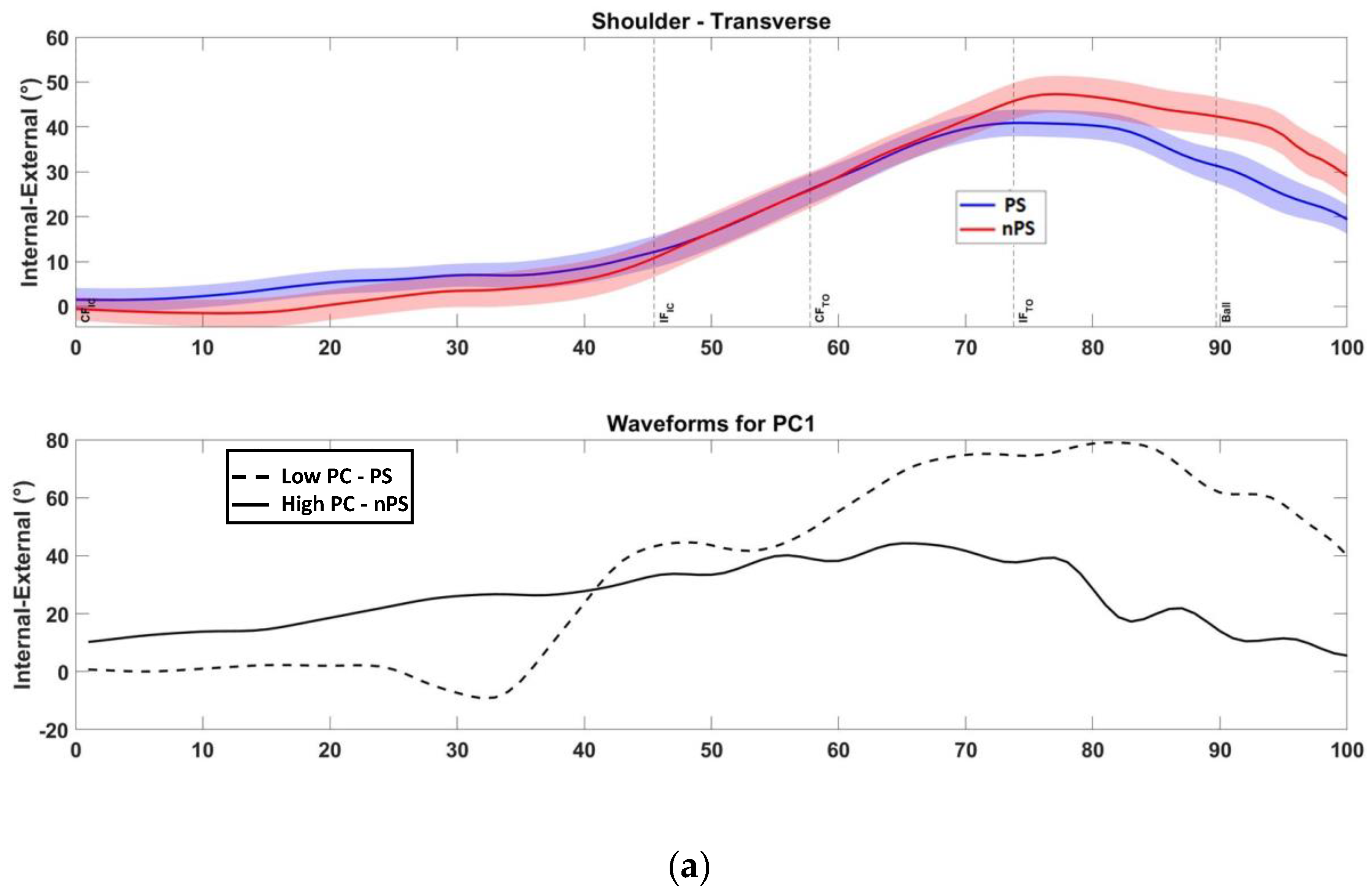


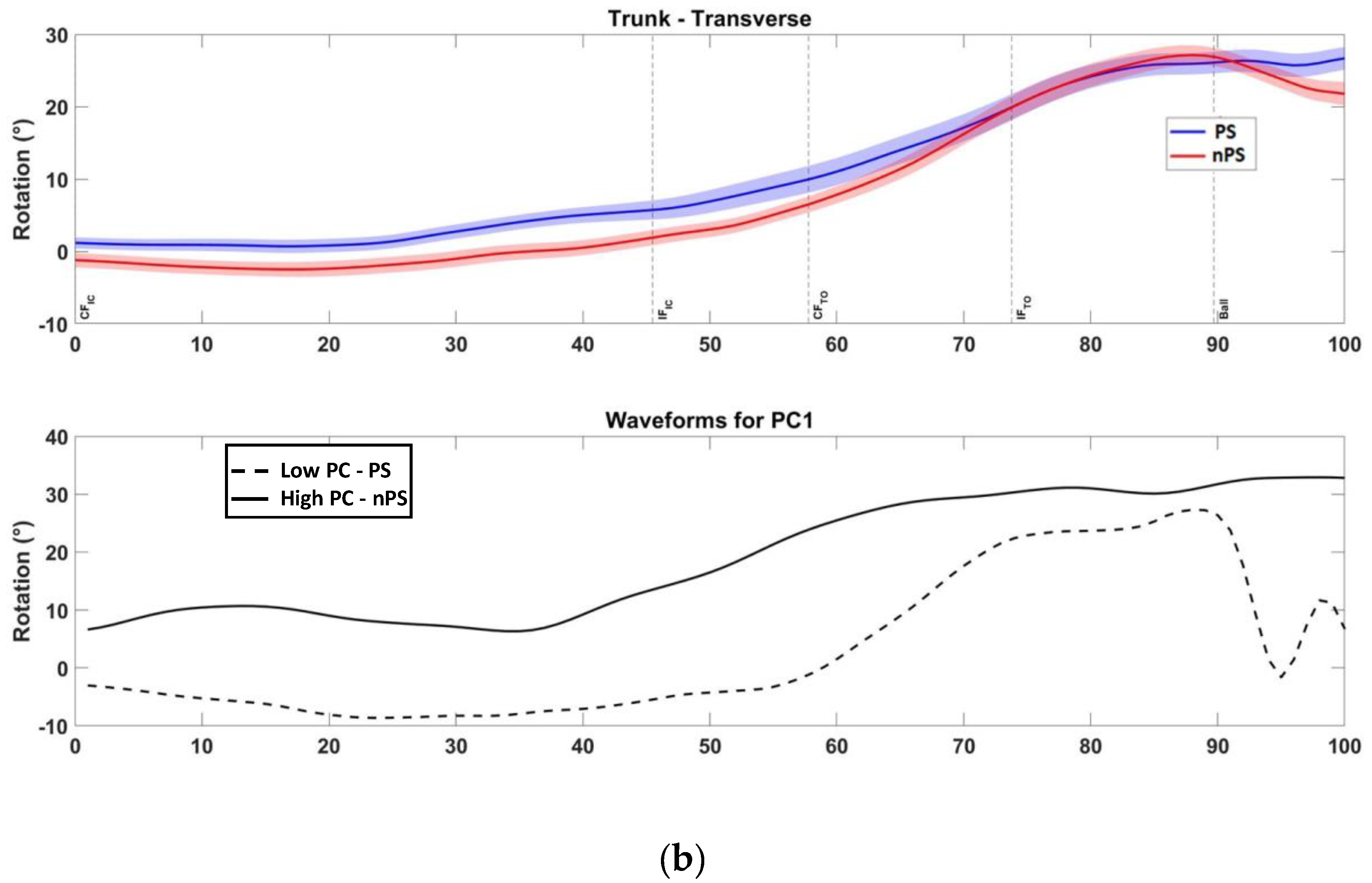
References
- Sørensen, H.; Thomassen, M.; Zacho, M. Biomechanical Profile of Danish Elite and Sub-Elite Soccer Goalkeepers. Footb. Sci. 2008, 5, 37–44. [Google Scholar]
- Spratford, W.; Mellifont, R.; Burkett, B. The Influence of Dive Direction on the Movement Characteristics for Elite Football Goalkeepers. Sports Biomech. 2009, 8, 235–244. [Google Scholar] [CrossRef] [PubMed]
- Ibrahim, R.; Kingma, I.; de Boode, V.; Faber, G.S.; van Dieën, J.H. Angular Velocity, Moment, and Power Analysis of the Ankle, Knee, and Hip Joints in the Goalkeeper’s Diving Save in Football. Front. Sports Act. Living 2020, 2, 13. [Google Scholar] [CrossRef] [PubMed] [Green Version]
- Otte, F.W.; Millar, S.-K.; Klatt, S. How Does the Modern Football Goalkeeper Train?—An Exploration of Expert Goalkeeper Coaches’ Skill Training Approaches. J. Sports Sci. 2020, 38, 1465–1473. [Google Scholar] [CrossRef]
- Ibrahim, R.; Kingma, I.; de Boode, V.A.; Faber, G.S.; van Dieën, J.H. Kinematic and Kinetic Analysis of the Goalkeeper’s Diving Save in Football. J. Sports Sci. 2019, 37, 313–321. [Google Scholar] [CrossRef] [Green Version]
- Zheng, R.; de Reus, C.; van der Kamp, J. Goalkeeping in the Soccer Penalty Kick: The Dive Is Coordinated to the Kicker’s Non-Kicking Leg Placement, Irrespective of Time Constraints. Hum. Mov. Sci. 2021, 76, 102763. [Google Scholar] [CrossRef]
- Matsukura, K.; Asai, T.; Sakamoto, K. Characteristics of Movement and Force Exerted by Soccer Goalkeepers During Diving Motion. Procedia Eng. 2014, 72, 44–49. [Google Scholar] [CrossRef] [Green Version]
- Ibrahim, R.; Kingma, I.; de Boode, V.; Faber, G.S.; van Dieën, J.H. The Effect of Preparatory Posture on Goalkeeper’s Diving Save Performance in Football. Front. Sports Act. Living 2019, 1, 15. [Google Scholar] [CrossRef]
- Chau, T. A Review of Analytical Techniques for Gait Data. Part 1: Fuzzy, Statistical and Fractal Methods. Gait Posture 2001, 13, 49–66. [Google Scholar] [CrossRef]
- Deluzio, K.J.; Astephen, J.L. Biomechanical Features of Gait Waveform Data Associated with Knee Osteoarthritis: An Application of Principal Component Analysis. Gait Posture 2007, 25, 86–93. [Google Scholar] [CrossRef]
- Federolf, P.A.; Boyer, K.A.; Andriacchi, T.P. Application of Principal Component Analysis in Clinical Gait Research: Identification of Systematic Differences between Healthy and Medial Knee-Osteoarthritic Gait. J. Biomech. 2013, 46, 2173–2178. [Google Scholar] [CrossRef] [PubMed]
- Kobayashi, Y.; Hobara, H.; Heldoorn, T.A.; Kouchi, M.; Mochimaru, M. Age-Independent and Age-Dependent Sex Differences in Gait Pattern Determined by Principal Component Analysis. Gait Posture 2016, 46, 11–17. [Google Scholar] [CrossRef] [PubMed]
- Bastiaansen, B.J.C.; Vegter, R.J.K.; Wilmes, E.; de Ruiter, C.J.; Lemmink, K.A.P.M.; Brink, M.S. Biomechanical Load Quantification Using a Lower Extremity Inertial Sensor Setup During Football Specific Activities. Sports Biomech. 2022, 1–16. [Google Scholar] [CrossRef] [PubMed]
- Di Paolo, S.; Nijmeijer, E.; Bragonzoni, L.; Dingshoff, E.; Gokeler, A.; Benjaminse, A. Comparing Lab and Field Agility Kinematics in Young Talented Female Football Players: Implications for ACL Injury Prevention. Eur. J. Sport Sci. 2022, 1–10. [Google Scholar] [CrossRef]
- Di Paolo, S.; Zaffagnini, S.; Pizza, N.; Grassi, A.; Bragonzoni, L. Poor Motor Coordination Elicits Altered Lower Limb Biomechanics in Young Football (Soccer) Players: Implications for Injury Prevention through Wearable Sensors. Sensors 2021, 21, 4371. [Google Scholar] [CrossRef]
- Wilmes, E.; de Ruiter, C.J.; Bastiaansen, B.J.C.; van Zon, J.F.J.A.; Vegter, R.J.K.; Brink, M.S.; Goedhart, E.A.; Lemmink, K.A.P.M.; Savelsbergh, G.J.P. Inertial Sensor-Based Motion Tracking in Football with Movement Intensity Quantification. Sensors 2020, 20, 2527. [Google Scholar] [CrossRef]
- Di Paolo, S.; Lopomo, N.F.; Della Villa, F.; Paolini, G.; Figari, G.; Bragonzoni, L.; Grassi, A.; Zaffagnini, S. Rehabilitation and Return to Sport Assessment after Anterior Cruciate Ligament Injury: Quantifying Joint Kinematics during Complex High-Speed Tasks through Wearable Sensors. Sensors 2021, 21, 2331. [Google Scholar] [CrossRef]
- van der Kruk, E.; Reijne, M.M. Accuracy of Human Motion Capture Systems for Sport Applications; State-of-the-Art Review. Eur. J. Sport Sci. 2018, 18, 806–819. [Google Scholar] [CrossRef]
- Quan, W.; Zhou, H.; Xu, D.; Li, S.; Baker, J.S.; Gu, Y. Competitive and Recreational Running Kinematics Examined Using Principal Components Analysis. Healthcare 2021, 9, 1321. [Google Scholar] [CrossRef]
- Chiu, L.Z.F.; Bryanton, M.A.; Moolyk, A.N. Proximal-to-Distal Sequencing in Vertical Jumping with and without Arm Swing. J. Strength Cond. Res. 2014, 28, 1195–1202. [Google Scholar] [CrossRef]
- Suzuki, S.; Togari, H.; Isokawa, M.; Ohashi, J.; Ohgushi, T. Analysis of the Goalkeeper’s Diving Motion. In Science and Football (Routledge Revivals); Routledge: London, UK, 1988; pp. 468–475. [Google Scholar]
- Ibrahim, R.; de Boode, V.; Kingma, I.; van Dieën, J.H. Data-Driven Strength and Conditioning, and Technical Training Programs for Goalkeeper’s Diving Save in Football. Sports Biomech. 2022, 1–13. [Google Scholar] [CrossRef] [PubMed]
- Pratt, K.A.; Sigward, S.M. Inertial Sensor Angular Velocities Reflect Dynamic Knee Loading during Single Limb Loading in Individuals Following Anterior Cruciate Ligament Reconstruction. Sensors 2018, 18, 3460. [Google Scholar] [CrossRef] [PubMed] [Green Version]
- Dicesare, C.A.; Minai, A.A.; Riley, M.A.; Ford, K.R.; Hewett, T.E.; Myer, G.D. Distinct Coordination Strategies Associated with the Drop Vertical Jump Task. Med. Sci. Sports Exerc. 2020, 52, 1088–1098. [Google Scholar] [CrossRef] [PubMed]
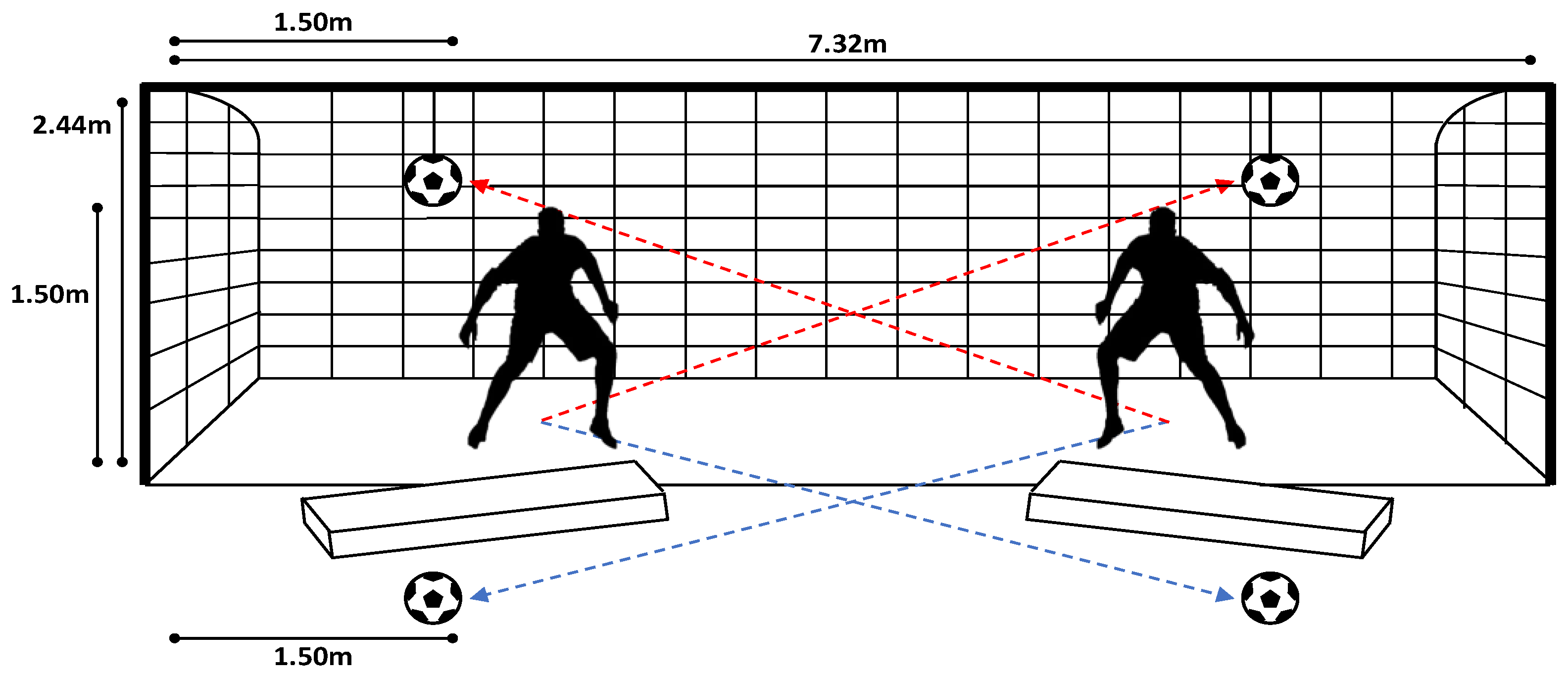


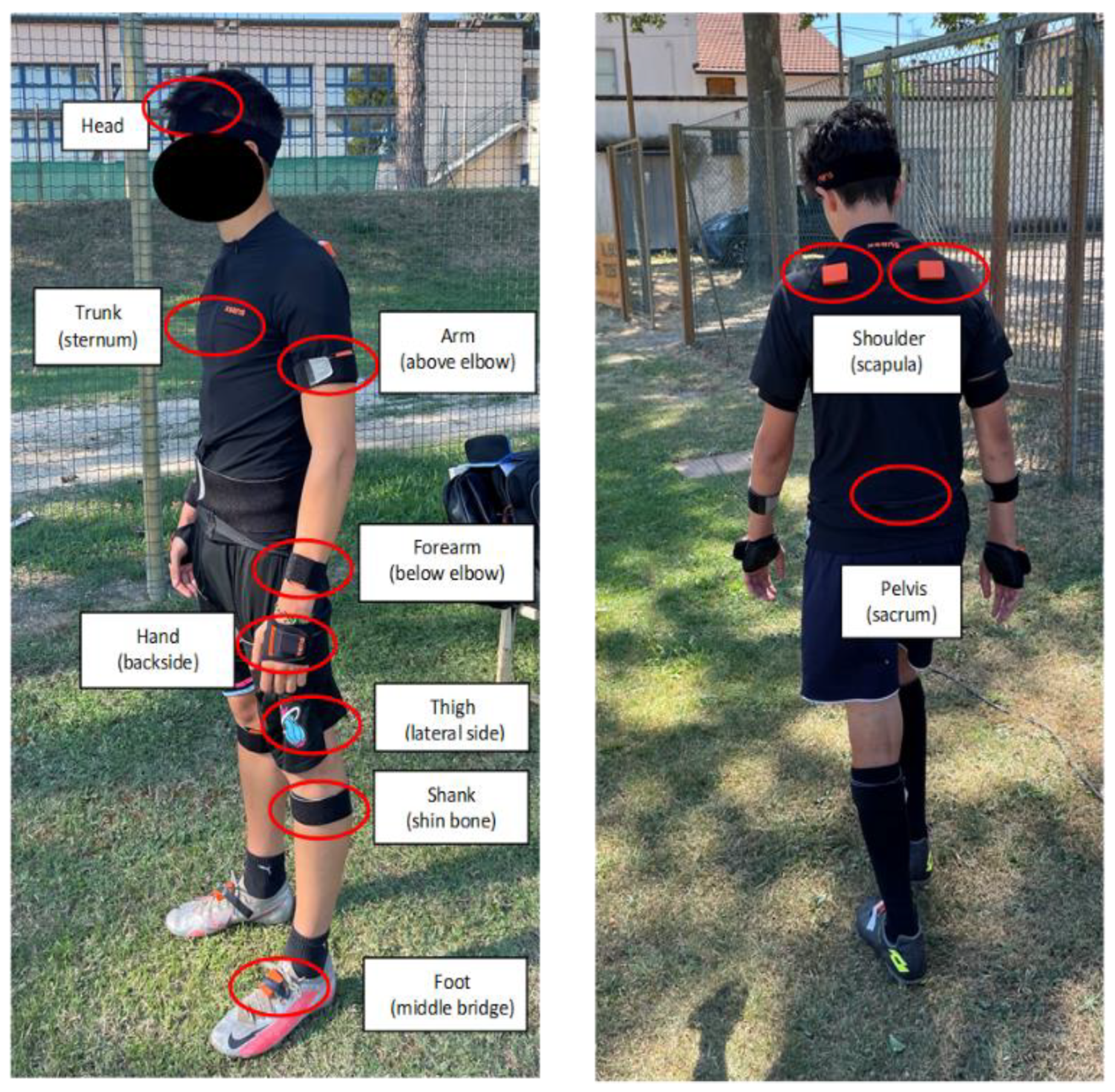
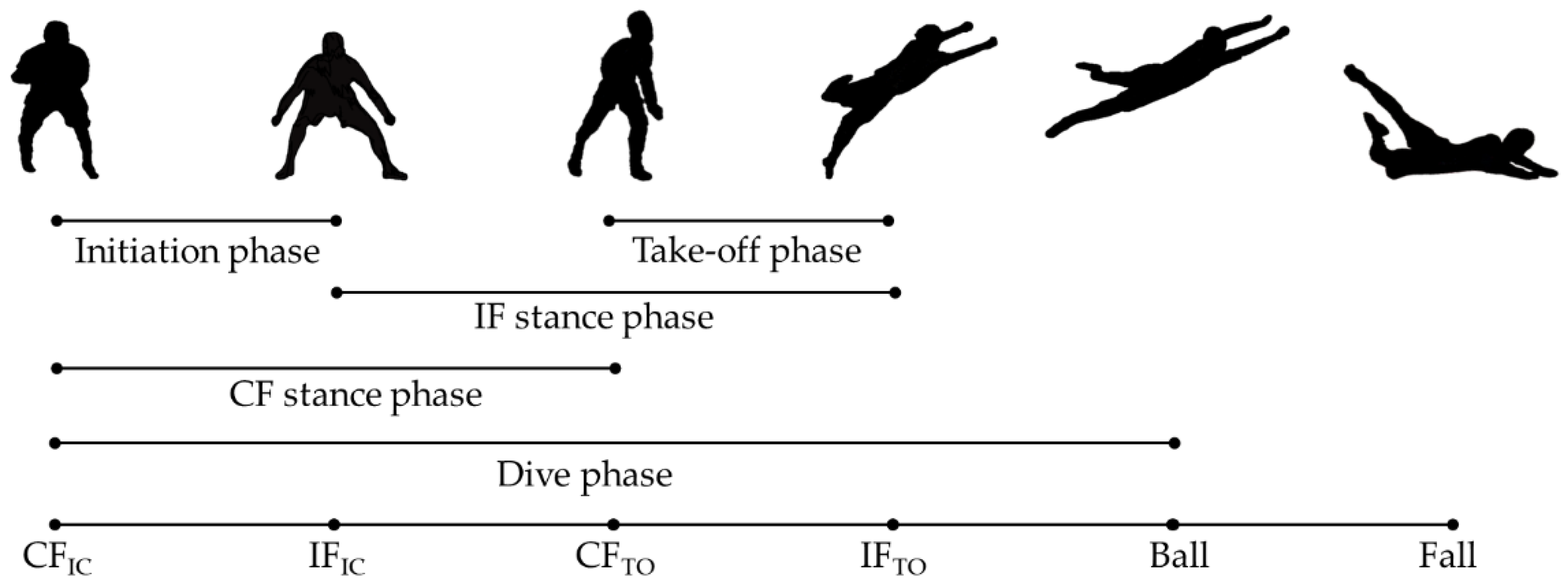
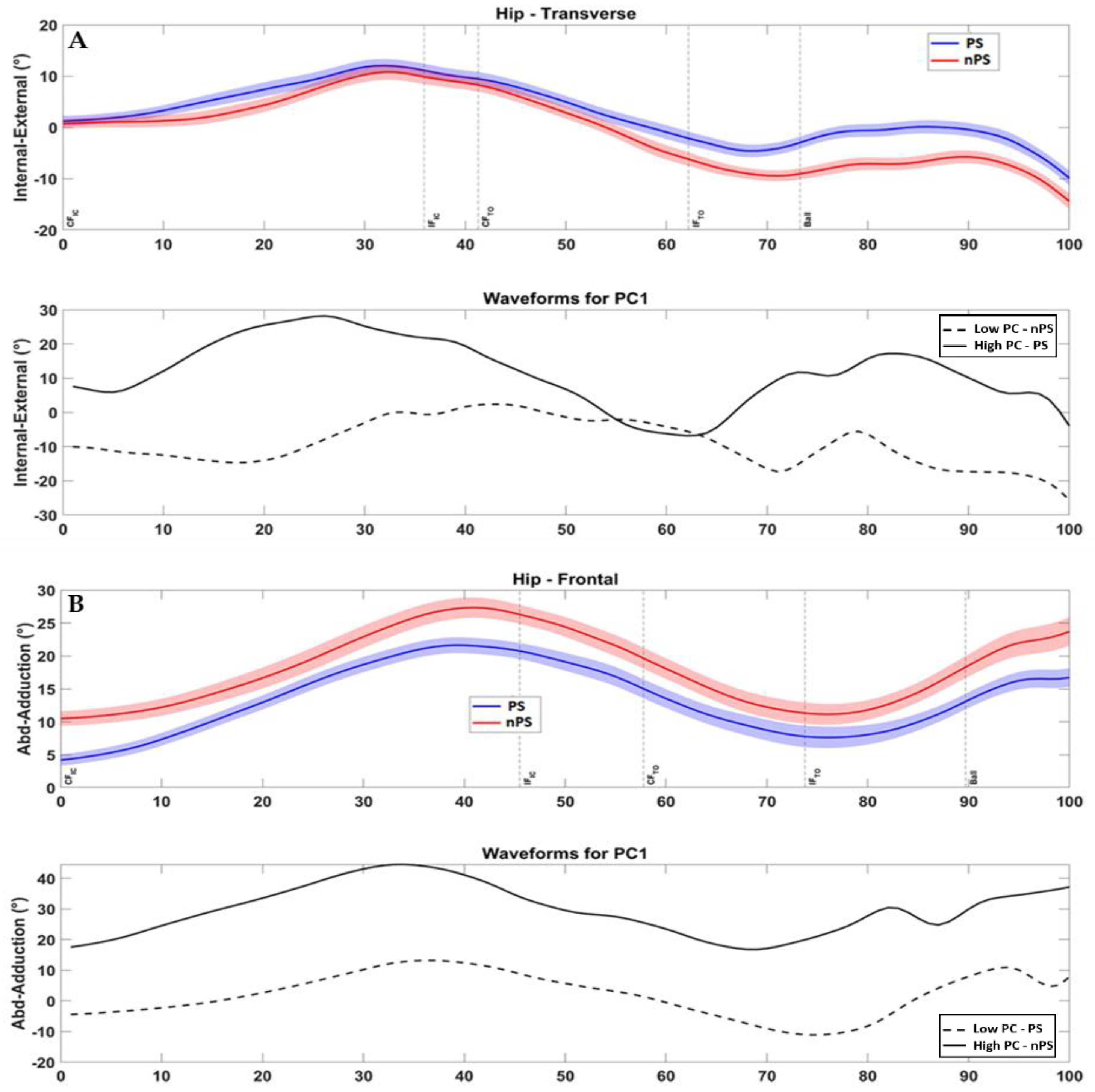

| Number of Players | 19 |
| Age (years) | 16.5 ± 3.0 [13–21] |
| Height (cm) | 176.0 ± 7.5 [158.6–187.1] |
| Mass (kg) | 70.2 ± 8.9 [50.8–86.1] |
| BMI | 22.6 ± 2.2 [19.5–27.2] |
| Preferred Side 1 (r/L) | 9/10 |
| Descriptives, Mean (SD) | Statistical Analysis (2-Way ANOVA) | ||||||||||||||
|---|---|---|---|---|---|---|---|---|---|---|---|---|---|---|---|
| Phase (s) | Overall | High Dive | Low Dive | Global | HLD | Side | HDL × Side | ||||||||
| PS | nPS | PS | nPS | R2 | R2 adj. | p | ηp2 | p | ηp2 | p | ηp2 | p | ηp2 | ||
| Initiation | 0.49 ± 0.19 | 0.45 ± 0.16 | 0.45 ± 0.16 | 0.51 ± 0.22 | 0.55 ± 0.18 | 0.05 | 0.03 | 0.020 | 0.05 | 0.003 | 0.04 | n.s. | 0.00 | n.s. | 0.00 |
| Take-off | 0.22 ± 0.09 | 0.26 ± 0.07 | 0.25 ± 0.06 | 0.18 ± 0.09 | 0.19 ± 0.09 | 0.17 | 0.16 | 0.000 | 0.17 | 0.000 | 0.17 | n.s. | 0.00 | n.s. | 0.00 |
| CF stance | 0.59 ± 0.20 | 0.51 ± 0.17 | 0.52 ± 0.17 | 0.64 ± 0.21 | 0.68 ± 0.17 | 0.14 | 0.12 | 0.000 | 0.14 | 0.000 | 0.13 | n.s. | 0.01 | n.s. | 0.00 |
| IF stance | 0.31 ± 0.08 | 0.32 ± 0.07 | 0.31 ± 0.06 | 0.31 ± 0.10 | 0.31 ± 0.08 | 0.00 | −0.01 | n.s. | 0.00 | n.s. | 0.00 | n.s. | 0.00 | n.s. | 0.00 |
| Dive | 0.96 ± 0.23 | 0.90 ± 0.23 | 0.91 ± 0.23 | 0.99 ± 0.24 | 1.03 ± 0.21 | 0.05 | 0.04 | 0.009 | 0.05 | 0.001 | 0.05 | n.s. | 0.00 | n.s. | 0.00 |
| Total | 1.19 ± 0.23 | 1.24 ± 0.23 | 1.25 ± 0.22 | 1.12 ± 0.26 | 1.17 ± 0.21 | 0.05 | 0.04 | 0.009 | 0.05 | 0.002 | 0.04 | n.s. | 0.01 | n.s. | 0.00 |
| Maximal Double-Leg Hop (cm) | 208.3 ± 22.9 |
| Maximal single-leg hop, PS (cm) | 180.2 ± 22.4 |
| Maximal single-leg hop, nPS (cm) | 179.6 ± 21.8 |
| Maximal 5-m frontal sprint (s) | 1.3 ± 0.1 |
| Maximal 5-m lateral sprint, PS (s) | 1.7 ± 0.1 |
| Maximal 5-m lateral sprint, nPS (s) | 1.7 ± 0.1 |
| Center of Mass in High Dive | Center of Mass in Low Dive | |||||||
|---|---|---|---|---|---|---|---|---|
| PS | nPS | p-Value | d | PS | nPS | p-Value | d | |
| Velocity (m/s, peak) | ||||||||
| Initiation | 2.8 ± 0.2 | 4.1 ± 5.6 | n.s. | 0.32 | 3.0 ± 0.9 | 3.4 ± 4.0 | n.s. | 0.15 |
| Take-off | 3.5 ± 0.3 | 3.8 ± 1.7 | n.s. | 0.29 | 3.7 ± 0.4 | 3.9 ± 1.6 | n.s. | 0.15 |
| CF stance | 2.9 ± 0.3 | 4.3 ± 5.6 | n.s. | 0.32 | 3.3 ± 0.9 | 3.7 ± 4.0 | n.s. | 0.14 |
| IF stance | 3.5 ± 0.3 | 3.9 ± 1.8 | n.s. | 0.31 | 3.7 ± 0.4 | 4.0 ± 2.6 | n.s. | 0.18 |
| Dive | 3.5 ± 0.3 | 4.9 ± 5.4 | n.s. | 0.35 | 4.1 ± 0.8 | 4.6 ± 3.9 | n.s. | 0.17 |
| Total | 4.2 ± 0.3 | 5.6 ± 5.3 | n.s. | 0.35 | 4.2 ± 0.8 | 4.6 ± 3.9 | n.s. | 0.17 |
| Acceleration (m/s2, range) | ||||||||
| Initiation | 12.6 ± 2.9 | 12.1 ± 3.0 | n.s. | 0.15 | 11.0 ± 3.2 | 11.3 ± 3.4 | n.s. | 0.09 |
| Take-off | 9.5 ± 4.2 | 9.0 ± 3.8 | n.s. | 0.13 | 6.5 ± 2.9 | 7.6 ± 4.4 | n.s. | 0.30 |
| CF stance | 13.8 ± 3.1 | 12.8 ± 3.2 | n.s. | 0.32 | 12.5 ± 2.6 | 12.3 ± 3.4 | n.s. | 0.07 |
| IF stance | 12.5 ± 4.5 | 11.8 ± 4.0 | n.s. | 0.16 | 10.0 ± 3.0 | 10.6 ± 4.5 | n.s. | 0.17 |
| Dive | 17.6 ± 3.7 | 17.1 ± 3.6 | n.s. | 0.15 | 18.7 ± 8.2 | 22.5 ± 16.1 | n.s. | 0.30 |
| Total | 20.7 ± 8.9 | 22.4 ± 13.1 | n.s. | 0.15 | 46.8 ± 17.2 | 46.6 ± 20.4 | n.s. | 0.02 |
| Kinematic Variable | Explained Variability (%) | PC Score PS | PC Scoren PS | p-Value | Effect Size | Feature Explanation |
|---|---|---|---|---|---|---|
| Lower Limb, Ipsilateral | ||||||
| Hip intra-extra rotation | 49.3 | 17.7 ± 67 | −16.4 ± 63.9 | 0.008 | 0.52 | Greater internal rotation peaks |
| Lower Limb, Contralateral | ||||||
| Hip intra-extra rotation | 43.6 | 5.8 ± 23.5 | −5.4 ± 28.4 | 0.029 | 0.43 | Greater external rotation and ROM before take-off |
| Knee varus-valgus | 26.2 | 6.2 ± 23.4 | −5.7 ± 15.8 | 0.002 | 0.60 | More valgus before take-off |
| Knee intra-extra rotation | 62.3 | −27.7 ± 83.7 | 25.7 ± 78.6 | 0.001 | 0.66 | Less ROM and greater external rotation before take-off |
| Pelvis/Trunk/Head | ||||||
| Trunk ipsilateral tilt | 11.1 | −6.4 ± 28.5 | 5.9 ± 34.7 | 0.047 | 0.39 | Greater ipsilateral tilt during take-off and ball contact |
| Kinematic Variable | Explained Variability (%) | PC Score PS | PC Score nPS | p-Value | Effect Size | Feature Explanation |
|---|---|---|---|---|---|---|
| Lower Limb, Ipsilateral | ||||||
| Hip abd-adduction | 17.2 | 10.2 ± 31.0 | −11.2 ± 43.3 | 0.003 | 0.57 | Greater abduction with less ROM |
| Lower Limb, Contralateral | ||||||
| Hip abd-adduction | 58.6 | −22.3 ± 71.3 | 24.4 ± 90.1 | 0.003 | 0.58 | Lower abduction (all movement) |
| Upper Limb, Contralateral | ||||||
| Shoulder intra-extra rotation | 21.3 | −23.6 ± 96.4 | 25.8 ± 141.1 | 0.034 | 0.41 | Greater internal rotation at take-off and ball contact |
| Wrist flexion-extension | 11.9 | 10.6 ± 45.7 | −11.6 ± 53.8 | 0.022 | 0.45 | Less extension during initiation and take-off |
| Pelvis/Trunk/Head | ||||||
| Pelvis ipsilateral rotation | 14.1 | −3.6 ± 14.3 | 4.0 ± 18.4 | 0.018 | 0.46 | Less ipsilateral rotation (all movement) |
| Trunk ipsilateral rotation | 14.0 | −8.6 ± 30.3 | 9.4 ± 42.9 | 0.012 | 0.49 | Less ipsilateral rotation (all movement) |
Publisher’s Note: MDPI stays neutral with regard to jurisdictional claims in published maps and institutional affiliations. |
© 2022 by the authors. Licensee MDPI, Basel, Switzerland. This article is an open access article distributed under the terms and conditions of the Creative Commons Attribution (CC BY) license (https://creativecommons.org/licenses/by/4.0/).
Share and Cite
Di Paolo, S.; Santillozzi, F.; Zinno, R.; Barone, G.; Bragonzoni, L. On-Field Biomechanical Assessment of High and Low Dive in Competitive 16-Year-Old Goalkeepers through Wearable Sensors and Principal Component Analysis. Sensors 2022, 22, 7519. https://doi.org/10.3390/s22197519
Di Paolo S, Santillozzi F, Zinno R, Barone G, Bragonzoni L. On-Field Biomechanical Assessment of High and Low Dive in Competitive 16-Year-Old Goalkeepers through Wearable Sensors and Principal Component Analysis. Sensors. 2022; 22(19):7519. https://doi.org/10.3390/s22197519
Chicago/Turabian StyleDi Paolo, Stefano, Francesco Santillozzi, Raffaele Zinno, Giuseppe Barone, and Laura Bragonzoni. 2022. "On-Field Biomechanical Assessment of High and Low Dive in Competitive 16-Year-Old Goalkeepers through Wearable Sensors and Principal Component Analysis" Sensors 22, no. 19: 7519. https://doi.org/10.3390/s22197519
APA StyleDi Paolo, S., Santillozzi, F., Zinno, R., Barone, G., & Bragonzoni, L. (2022). On-Field Biomechanical Assessment of High and Low Dive in Competitive 16-Year-Old Goalkeepers through Wearable Sensors and Principal Component Analysis. Sensors, 22(19), 7519. https://doi.org/10.3390/s22197519






